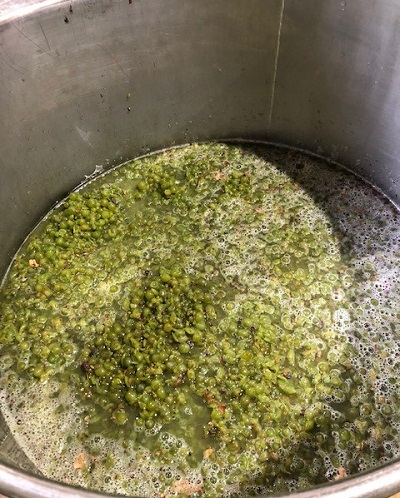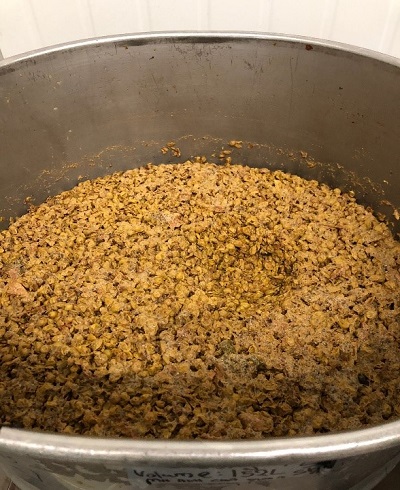

Figure 1. Amber wine treatment – fermented on skins at the start (left) and end of fermentation (right)
What is amber wine?
Amber or ‘orange’ wines are wines made from white grapes using techniques traditionally used for red winemaking. This involves fermentation on skins, seeds and sometimes stems and can include extended skin contact post-fermentation. Amber winemaking is different from pre-maceration skin contact techniques, where white grape juice is left in contact with skins for a period before fermentation but then pressed and fermented off-skins. This technique is addressed on the skin contact page.
Amber wine fermentations are often performed warm and are not temperature controlled, and at the end of the fermentation the wine is typically orange in colour (Figure 1). Such wines can also appear white, yellow or pink, dependent on the variety and process undertaken. Some winemakers may choose to make amber wines using options such as natural yeasts, allowing film-forming yeast to grown on the wine surface and fermenting in different types of amphorae, barrels or tanks. Amber wines can be made both with and without addition of sulfur dioxide to the finished wine.
In the amber treatment in the 2019 Chardonnay trial, fruit was hand-harvested and no sulfur dioxide was added. The fruit was crushed, destemmed and then fermented on skins and seeds, pressed once dry. A typical sulfur dioxide regime was then implemented for wine storage as for the other white wine treatments until the wine was bottled.
Cautions on use of the term ‘orange wine’
To consumers, a wine labelled ‘orange wine’ could be interpreted as a wine of orange colour, but also could be misconstrued as a wine made in the GI region of Orange or even a fruit wine fermented from oranges (Guy 2014). Some producers have thus begun using ‘amber wine’ as an alternative description. For assistance with legal requirements regarding labelling these wine styles in Australia, contact the compliance team at Wine Australia on labels@wineaustralia.com.
Background
Whilst seemingly a new trend, it could be argued that amber wine is the traditional way white wine was made prior to the use of sulfur dioxide, other preservatives and inert gas cover and before refrigeration techniques were commonly implemented to control white wine fermentations in the 1950s. These winemaking practices allowed more reductive white winemaking techniques to be employed to make fresh, aromatic, varietal white wine styles by both cooler slower fermentations and preventing juice and wine oxidation. Other modern winemaking practices that maximise varietal characters and minimise oxidation, coarseness or bitterness include gentle or whole bunch pressing, separate processing of free run and press fractions and fining processes that decrease must phenolics. Use of these reductive and gentler handling techniques also now allows amber wine to be made in a more controlled manner.
Amber winemaking is considered a regional specialty in places such as Georgia, Friuli and Sicily in Italy, and parts of Spain, Slovenia and Switzerland. Low aromatic varieties are often used that benefit from additional flavours from winemaking techniques or varieties with high amounts of flavonol glycosides found exclusively in their skins, which have potential to contribute additional flavour. Varieties high in phenolics and high in acid can appear harsh and bitter when made in amber style, with some winemakers choosing to hyperoxidise juice to decrease phenolics content when making amber wines. Phenolic under-ripeness can also add bitterness and astringency to amber styles. Conversely overripe fruit and high pH can make amber wines appear broad and ‘blousy’. In Australia, varieties used for amber wine include Riesling, Chardonnay, Pinot Gris, Gewürztraminer, Semillon, Sauvignon Blanc, Muscat and Viognier.
Wine style
Amber wines are typically orange in colour, dry and have noticeable tannin astringency. Skin contact aims to increase the extraction of aroma and phenolic compounds from the skins, seeds and any stems, to optimise the tannin structure, texture and mouth-feel and add ‘savoury’ complexity. There is typically greater extraction of phenolics compared to pre-fermentation skin contact techniques. As white grapes contain lower concentrations of anthocyanins than red grapes, extracted tannin is less likely to be retained in the wine compared to red wines. Amber wines thus have some tannin astringency but are mostly less astringent than red wines. Amber wines are generally intended to be drunk at room temperature and are often considered ‘food wines’.
Gawel et al. (2013, 2016) found that both pH and alcohol play a role in perceived astringency, tannin and overall texture in white wines with solids or skin contact. Higher pH wines were considered less astringent; high alcohol wines were perceived as more bitter. The actual phenolic concentration in a wine was far less important in regard to the perceived bitterness. The types of phenolics extracted from skin and pulp comprise a diverse group of compounds, some in a simple free form and others in more complex esters with wine sugars, acids or amino acids, which can all influence how they taste and feel in the mouth, with some phenolic components even reducing perceived astringency.
An increase in pH up to 0.2 pH units can be expected when white grapes are fermented on skins. Lower alcohol levels have also been observed either from absorption by stems or from greater ethanol evaporation due to warmer fermentation temperatures or fermentations being conducted in open-top fermenters (Townshend 2019).
Potential risks
Extended skin contact in white wine can result in large changes in the chemical composition and the sensory characteristics of wine. The most commonly reported risks are the potential development of bitterness and overly astringent tannins, overt oxidation and the possibility of spoilage by undesirable yeast or bacteria. Consequently, it is advisable to take a cautious approach when trialling the technique, by starting with a small batch and assessing the results over time.
References
- Cowey, G. 2020. Ask the AWRI: Amber wine. Aust. N.Z. Grapegrower Winemaker (678): 49-50.
- Gawel, R. Day, M. Schulkin, A. Herderich, M. Johnson, D. 2013. The science of texture. Wine Vitic. J. 28(2): 30-34.
- Gawel, R. Day, M. Schulkin, A. Day, M. Barker, A. Smith, P. 2016. Interactions between phenolics, alcohol, and acidity in determining mouthfeel and bitterness of white wine. Wine Vitic. J. 31(1): 30-34.
- Guy, S. 2014. The reasons for raising a red flag to the use of the term ‘orange’. Wine Vitic. J. 29(4): 10.
- Townshend, E.R., Harrison, R., Tian, B. 2019. The phenolic composition of orange wine — effects of skin contact and sulfur dioxide addition on white wine tannin. Wine Vitic. J. 34(2): 25-32.

